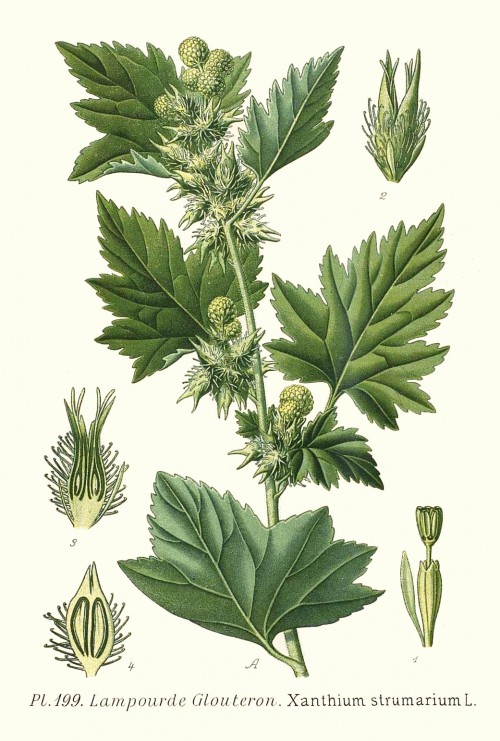Dies ist eine alte Version des Dokuments!
Xanthium strumarium L. - syn. anthium sibiricum Patrin ex Widder - Asteraceae
苍耳 cang er (chin.), Siberian cocklebur, (large) cocklebur, Gewöhnliche Spitzklette, Sibirische Spitzklette
Annual herb, up to 120cm high, exact native range unknown, probably North America, extensively naturalized elsewhere; leaves ovate-deltate, 9-25 cm, papery, densely scabrid on both surfaces, margin irregularly dentate, male capitula in terminal umbels, corolla white, tubular, ca. 2.5mm, female capitula axillary. http://www.efloras.org/florataxon.aspx?flora_id=2&taxon_id=220014370
„The pistillate heads consist of two pistillate flowers surrounded by a spiny involucre. Upon fruiting, these two flowers ripen into two brown to black achenes and they are completely enveloped by the involucre, which becomes a bur. The bur, being buoyant, easily disperses in the water for plants growing along waterways. However, the bur, with its hooked projections, is obviously adapted to dispersal via mammals by becoming entangled in their hair.“ https://en.wikipedia.org/wiki/Xanthium_strumarium
„The ethanol extract of X. strumarium (EXS) was fractionated on the basis of polarity. Among the different fractions, the n-butanol fraction showed the highest anti-inflammatory activity in the croton-oil-induced ear edema test and furthermore reduced the number of writhings induced by acetic acid in mice in a dose-dependent manner… The isolated caffeoylquinic acids could partially explain the antinociceptive effect of X. strumarium polar extract.“
[Bioactivity-guided fractionation for anti-inflammatory and analgesic properties and constituents of Xanthium strumarium L., Han, T., Li, H.L., Zhang, Q.Y., Han, P., Zheng, H.C., Rahman, K., Qin, L.P., Phytomedicine: international journal of phytotherapy and phytopharmacology, 14(12), 2007, 825]
„Xanthii Fructus (XF) which is well known as “Cang-Erzi” in Taiwan is the dried fruit of Xanthium strumarium
L. Aqueous extract of this fruit has been used for treatment of various diseases for treating sinusitis, headache due to rheumatism and skin pruritus (Hsu et al., 1985; Hsu et al., 2000). XF was reported to have inhibitory effects on mast cell-mediated allergic reaction (Hong, et al., 2003), anti-inflammatory actions in lipopolysaccharide-stimulated inflammatory responses (An, et al., 2004) and prevent of ß-cell damage in type 1 diabetes (Song, et al., 2009)… Statistical analysis revealed that AXF (1.0 g/kg) significantly inhibited the development of Carr-induced paw edema after 3h of treatment…“
[Antioxidant, antinociceptive, and anti-inflammatory activities of Xanthii Fructus extract., Huang, M.H., Wang, B.S., Chiu, C.S., Amagaya, S., Hsieh, W.T., Huang, S.S., Huang, G.J., Journal of Ethnopharmacology, 135(2), 2011, 545-552]

Masclef, A., Atlas des plantes de France, vol.2 t.199 (1890)
http://plantgenera.org/species.php?id_species=1076131
